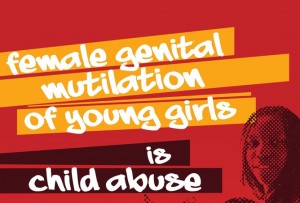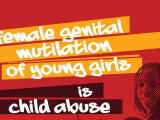Female genital mutilation (FGM) is happening across the UK but despite being illegal for nearly 30 years, there have been no convictions.
By Hazel Barrett, Coventry University
Fortunately, politicians are beginning to pick up on the issue. A report from a committee of MPs today warns the UK “is weakened by its failure to address [FGM] violence within its own borders”. They say it’s “unforgiveable”  that there hasn’t been a single prosecution since the procedure was made illegal here in 1985.
that there hasn’t been a single prosecution since the procedure was made illegal here in 1985.
FGM is a deep rooted traditional practice that has a huge impact on the health and well being of millions of girls and young women around the world. It’s a common practice in 28 African countries, as well as parts of the Middle East and Asia. In some countries such as Djibouti and Mali, more than 90% of women are believed to have undergone FGM. In Egypt it is illegal but the country still has one of the highest rates in the world. Only recently, 13-year-old Suhair al-Bata died after undergoing the procedure in a village north of Cairo.
But FGM is not restricted to these countries. Globalisation and ease of travel means many Africans migrating to the EU and other developed regions – for economic reasons or asylum – has spread the practice. FGM is now taking place in EU countries and is on the increase.
In England and Wales it’s estimated that 66,000 women are already living with FGM and a further 21,000 girls are at risk of being cut.
Anecdotal evidence collected as part of our research suggests that some EU citizens are moving between member states to take advantage of differences in legislation – making the UK a destination for many families who want FGM for their daughters and believe the law isn’t applied here.
What is FGM?
FGM involves removing part or all of the external parts of a girl or woman’s genitalia but also includes procedures that cause injury to that part of the body for cultural or other non-therapeutic reasons. The UN regards the practice of FGM as a violation of human and female reproductive health rights. Many now recognise it as a form of violence against girls and women and further, a form of torture.
The ritual is usually performed by traditional practitioners who have no formal medical training and perform the operation in non-sterile conditions. It can cause serious physical harm such as complications in childbirth, excessive bleeding, blood poisoning, death and HIV transmission, and psychological damage.
The World Health Organisation classifies FGM into four types. Type III is the most serious kind and often involves women having to be cut open again to have sexual intercourse and for childbirth. It’s estimated that globally 90% of women affected by the practice have been subjected to full or partial removal of their clitoris and/or the removal of their inner labia and other “unclassified” procedures, including the use of cauterisation.
Where did FGM come from?
The origins of FGM are unknown; it doesn’t appear to be connected to any particular religion or culture, but perpetuated over generations by social dynamics.
It is often defended as a rite of passage from girlhood into womanhood and usually performed on girls from babyhood up until the age of 15. Support comes directly from mothers, mothers-in-law, and elder women. But FGM isn’t “women’s business” as it’s often seen. All the communities where it is common are highly patriarchal. And men wield a lot of influence – indirectly from fathers, religious and community leaders.
Pain is an important element of the ritual that it is said prepares girls for the pain of childbirth – even though it can cause later complications. Sometimes FGM is performed for “purity” or “hygiene” and some people also believe, wrongly, that FGM is just a female version of male circumcision.
Overcoming cultural barriers
At Coventry University we headed up two European-funded projects: one looking at Somali and Sudanese communities in the UK and Holland and another, which has just started, at different African FGM practising communities across six EU countries.
It’s clear that we need to get away from cloaking FGM in medical terminology. Many practising communities also have their own definitions and language for the procedure which are difficult to relate to the WHO’s “type” classifications. Various differences that individuals and communities place on certain terminology make it extremely difficult to work out the various types of genital cutting and how often it happens.
Many people in the communities that we worked with don’t regard FGM as “mutilation” so that can lead to confusion about what type of cutting is covered by legislation. Many find the term FGM offensive and equate it with the worst kind of procedures, which we’ve found many don’t support. Using the term “sunna”, which loosely equates with FGM types I and II, can be better.
We need more information
In the 1990s, 14 African countries including Ethiopia, Uganda, Ghana, Senegal and Togo, together with Egypt and Djibouti and six of the Federal States in Nigeria effectively banned FGM. But today, there is little evidence the situation is changing. Practising communities in the UK are from countries where FGM is common and include Somalian, Sudanese, Gambian and Nigerian communities.
But we still lack information. Only in Egypt and Sudan is some data available to properly work out trends. For example, we know that there was a decline in FGM from 96% of women in 1979 to 89% in 1990 in Sudan. This was accompanied by a 10% shift from the worst type of FGM to a less drastic form.
In Egypt, surveys showed that girls are now less likely to be cut than their mothers. Some credit urbanisation and increased access to education for girls as partly responsible; others suggest that the high international profile of the practice and the criminalising of the practice in some countries have also played a role.
But elimination of FGM is proving very difficult. Despite campaigns to explain to communities the health implications of the rite and the criminalisation of the practice in many countries, FGM has continued. The link between social structures and gender power relations and sexuality mean it’s very resistant to change. The failure to conform can affect how well a girl marries and her family’s standing. Turning against it can lead to social exclusion, ostracism or even violence.
Family honour and social expectations play a powerful role in perpetuating FGM, making it extremely difficult for individual families, as well as individual girls and women, to stop the practice on their own.
This is also true of the UK; it’s clear that pressure from the community makes it hard for people to go against it. To tackle the problem we need not just to change the behaviour of individual people, for example those doing the cutting, but tackle wider issues concerning the beliefs held by the community that perpetuate the practice making it ‘normal’.
Ending FGM in the UK is going to take time, but understanding more about it and taking new approaches to change individual and community behaviour will push us towards the tipping point that we need – when communities accept that FGM is no longer necessary or acceptable and individuals (parents and children) have the power to say no.
Hazel Barrett receives funding from European Commission’s Daphne III programme
![]()
This article was originally published at The Conversation.
Read the original article.




Comments are disabled